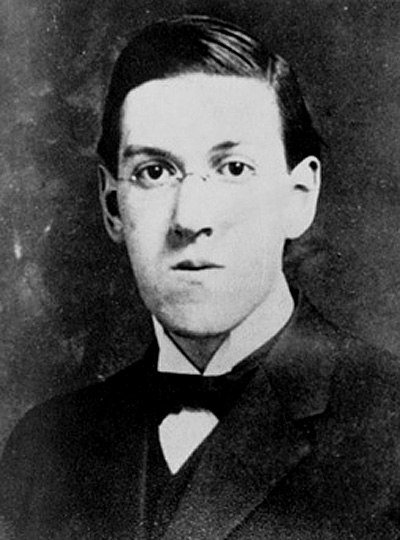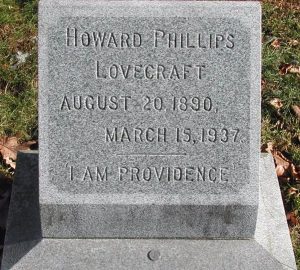Known as the Father of Cosmic Horror, H.P. Lovecraft only lived for forty-six short years. What he was able to accomplish in his lifetime, however, was enough to change the tides of an entire genre.
A Visionary from an Early Age
Howard Phillips Lovecraft was born in the late summer of 1890, to Sarah Susan Phillips Lovecraft and Winfield Scott Lovecraft, in Providence, Rhode Island. As a child of three, his father suffered from a nervous breakdown and was sent to Butler Hospital, where he remained in residence for five years until his death in the summer of 1898. Unaware of his father’s mental condition, Lovecraft was told that his father was paralyzed and comatose, but surviving medical records show that his father actually died of paresis—a form of neurosyphilis.
Following the death of his father, Lovecraft was brought up by his mother, two aunts, and grandfather—who had him reciting poetry at two, reading at three, and writing at six or seven years of age, having recognized his advanced intelligence. By the age of five, he had proven his penchant for the creative, fantastical, and mythological, eventually using these influences to inspire his own literary works. His oldest surviving work came when he was a young boy of seven, having paraphrased the Odyssey into rhyming verse in his 1897, “The Poem of Ulysses.” His grandfather played a large role in Lovecraft’s strange gothic sense of fantasy, encouraging him to pursue his weird flights of fantasy into the realm of horror.
Due to numerous childhood afflictions, including some instances of psychological troubles, Lovecraft’s attendance at school was never consistent—he spent much of his youth studying independently, favoring chemistry and astronomy over all else. As far as works of fiction, Edgar Allan Poe served as the inspiration for much of Lovecraft’s dark and imaginative creations. Despite his diminished ability to socialize, he was still able to create and maintain a number of significant friendships with his peers when he attended Hope High School, through his self-published hectograph journals. These journals, The Scientific Gazette (1899–1907) and The Rhode Island Journal of Astronomy (1903–07) garnered him his peer’s encouragement to write outside of his home. Unfortunately, in 1908 Lovecraft suffered from a nervous breakdown and never received his diploma. His inability to graduate high school and be admitted into Brown University would be a source of great shame to Lovecraft later in life
This breakdown led Lovecraft to become somewhat of a hermit for several years—exacerbated by the death of his grandfather and their consequential financial ruin—he would stay up late studying, reading, and writing poetry, then sleeping late into the day. Even though he managed to publish articles on astronomy in several newspapers, Lovecraft went through a difficult time after losing his childhood home, as well as the compulsive love-hate relationship he had with his mother, so he regularly contemplated suicide.
From Isolation to Notoriety
Emerging from his need for isolation in 1913, like an internet troll emerges when they see something online that drives them absolutely crazy, Lovecraft wrote an entire letter in verse to Fred Jackson as an affront. He joined the United Amateur Press Association in 1914, which is where his amateur journalism career began, leading him to launch his self-published magazine The Conservative in 1915. It would be safe to say that these opportunities launched Lovecraft’s entire career out from within the pit of his own self-pity.

“In 1914, when the kindly hand of amateurdom was first extended to me, I was as close to the state of vegetation as any animal well can be… With the advent of the United I obtained a renewal to live; a renewed sense of existence as other than a superfluous weight; and found a sphere in which I could feel that my efforts were not wholly futile. For the first time I could imagine that my clumsy gropings after art were a little more than faint cries lost in the unlistening world.”
Howard Phillips Lovecraft
It only took two more years of his life before he once again delved into his fictional worlds—in the summer of 1917, Lovecraft easily produced “The Tomb,” as well as “Dagon,” which were two shorter stories that he owed to his passion for fiction. The dark edgy tales of Edgar Allan Poe and fantasy tales of Irish author Lord Dunsany, which inspired some of his earlier fiction pieces.
I will tell only of the lone tomb in the darkest of the hillside thickets; the deserted tomb of the Hydes, an old and exalted family whose last direct descendant had been laid within its black recesses many decades before my birth.
“The Tomb”, June 1917 by Howard Phillips Lovecraft
It was around this time that his mother’s own mental and physical deterioration began to really affect her and after her own nervous breakdown in 1919, she was admitted to Butler Hospital—the same hospital Lovecraft’s father had been committed to and subsequently died in. Only two years later a failed operation caused the death of his mother and in spite of his devastation, Lovecraft recovered enough to meet his future wife a few weeks later. In 1923, the horror magazine Weird Tales paid Lovecraft for his stories, which was his first paid gig as a writer. When he married Sonia Greene in 1924, they moved to New York for two years, but the marriage soon failed and Lovecraft returned to Rhode Island where he began working on his most renowned stories. Just two years after splitting up with his wife, “The Call of Cthulhu,” came out in the Weird Tales magazine, which was the first piece that really helped make a name for Lovecraft as an author of otherworldly horror.
The Death of a Legendary Horror Writer
I am essentially a recluse who will have very little to do with people wherever he may be. I think that most people only make me nervous – that only by accident, and in extremely small quantities, would I ever be likely to come across people who wouldn’t.
Howard Phillips Lovecraft, 1926

The last decade of his life was spent creating what is now known as his classics, having found a niche for himself as an author of weird horror fiction, and prolific writer-of-letters. The last few years of his life, in particular, were incredibly strenuous for Lovecraft, beginning with the death of one of his aunts in 1932, from there his writing became largely too complex to sell to a normal reader. At this part of his career, he began to attempt a career solely editing, as well as ghostwriting stories, poetry, and non-fiction—no longer even trying to sell his own original creations. The suicide of a close friend brought him depression, but it was ultimately his own incurable illness that would bring Lovecraft’s final days. In the winter of 1936, Lovecraft’s intestinal cancer caused him pain that increased on a daily basis and eventually he had taken himself to the hospital where he died five days later, on March 15, 1937.
Like many other underappreciated artists of his age, Lovecraft has gained a far greater following after death than he ever saw during his lifetime. He’s been the inspiration for writers Peter Straub, Stephen King, as well as Neil Gaiman—to name a few.
Lovecraft has yet to be surpassed as the twentieth century’s greatest practitioner of the classic horror tale.
Stephen King

Georgia-based author and artist, Mary has been a horror aficionado since the mid-2000s. Originally a hobby artist and writer, she found her niche in the horror industry in late 2019 and hasn’t looked back since. Mary’s evolution into a horror expert allowed her to express herself truly for the first time in her life. Now, she prides herself on indulging in the stuff of nightmares.
Mary also moonlights as a content creator across multiple social media platforms—breaking down horror tropes on YouTube, as well as playing horror games and broadcasting live digital art sessions on Twitch.
